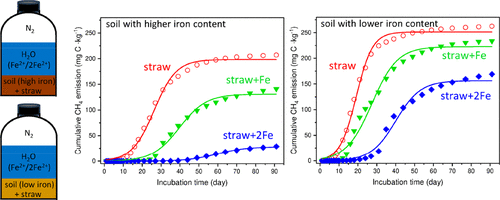当前位置:
X-MOL 学术
›
ACS Earth Space Chem.
›
论文详情
Our official English website, www.x-mol.net, welcomes your feedback! (Note: you will need to create a separate account there.)
Ferrous Iron Addition Decreases Methane Emissions Induced by Rice Straw in Flooded Paddy Soils
ACS Earth and Space Chemistry ( IF 3.4 ) Pub Date : 2020-05-11 , DOI: 10.1021/acsearthspacechem.0c00024 Jinli Hu 1, 2 , Hongtao Wu 1, 2, 3 , Zheng Sun 1, 2, 4, 5 , Qi-an Peng 6 , Jinsong Zhao 1, 2 , Ronggui Hu 1, 2
ACS Earth and Space Chemistry ( IF 3.4 ) Pub Date : 2020-05-11 , DOI: 10.1021/acsearthspacechem.0c00024 Jinli Hu 1, 2 , Hongtao Wu 1, 2, 3 , Zheng Sun 1, 2, 4, 5 , Qi-an Peng 6 , Jinsong Zhao 1, 2 , Ronggui Hu 1, 2
Affiliation

|
Straw returning to fields is a common agricultural practice for enhancing soil fertility and organic matter, although it induces substantial CH4 emissions from flooded paddy soils. The characteristics of long-term periodic management of irrigation and drainage intensely affect the redox cycling of iron in paddy soil and could be one of the major factors regulating CH4 production. Currently, this regulatory effect is rarely applied to CH4 mitigation during straw returning to fields. To clarify the influences of iron on CH4 emissions induced by straw incorporation, an laboratory incubation experiment was conducted with the addition of rice straw and two different concentration levels of ferrous iron (3.7 and 7.4 g of Fe2+ kg–1 of soil) to two paddy soils (collected from Luotian, Hubei Province, and Changsha, Hunan Province, China, hereafter called LT and CS soils, respectively). Our result showed that CH4 emissions from straw addition treatment were 125.4 and 45.5 times greater than the amount without straw addition in LT and CS soils, respectively. Fe2+ addition significantly decreased CH4 emissions induced by rice straw by over 50% in both soil samples. Moreover, the stimulation of straw on CH4 emission was almost offset by twice the content of Fe2+ amendment in LT soil. Fe2+ addition significantly decreased the dissolved organic carbon (DOC) content, with 21–39% in LT soil and 31–42% in CS soil, compared to the straw addition treatment. The Fe(II) accumulation rate, microbial biomass carbon content, and CO2 emissions were also suppressed by Fe2+ addition. These results indicate that the addition of Fe2+ suppressed the reduction of Fe(III) to Fe(II), leading to less DOC release from Fe–organic matter associations. The microbial activity and biomass could be influenced by the DOC availability, leading to further inhibition of CH4 emissions. Our result implies that Fe-rich soils may be more suitable for returning straw, and further research about methanogens and methanotrophs is needed.
更新日期:2020-06-18



























 京公网安备 11010802027423号
京公网安备 11010802027423号